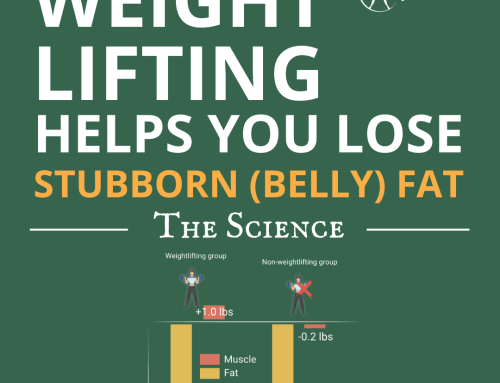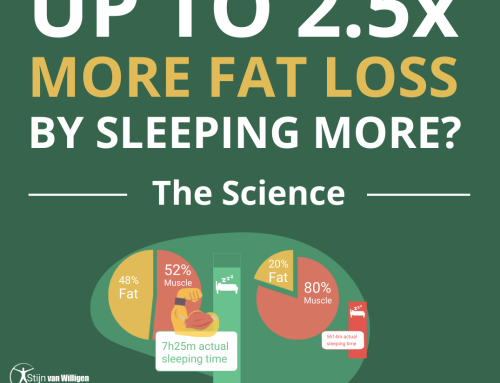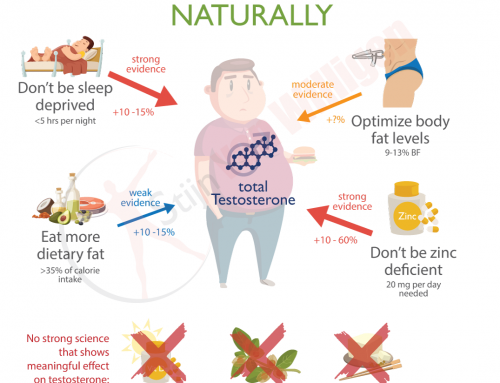A firm butt, a juicy booty, a round butt, godly glutes, a cherry bottom…
Whatever you want to call it, you know what it looks like.
But what gets a booty so juicy? What makes a butt so firm?
1 word: size.
Muscle size, to be precise. Underneath that cushion of fat there are undeniably some slaps of butt muscle: the glutes.
The main glute muscles are the Gluteus Maximus and the Gluteus Medius, shown in the picture below.

As you can see, the Gluteus Maximus is a lot bigger than the Gluteus Medius. Even better: the Gluteus Maximus is the biggest muscle in the entire body! Hence, you can’t argue with the fact that the remainder of this article will focus on the Gluteus Maximus. From here, I will refer to this specific muscle as the ‘the glutes’.
Note: when you move your mouse over (or: tap your finger on) the sentences that are bold, you will see the scientific citation that supports it.
What gets glutes bigger?
Weight training! You have to stimulate a muscle in order for it to grow. Now that brings us to the key question of this article: what exercise is best at doing this?
Muscle activity causes muscle growth
The degree of muscle activation during an exercise is a good indicator for growth of that specific muscle! [Wak’13, Dic’10] Because of this, we have to look at which exercise shows the most activity for the glutes.
How is muscle activity measured?
Tons of studies have been conducted on muscle activition during exercises. Muscle activity is measured by sensing the electric currents that go from the nervous system to the muscle fibers. This sensing is done by electrodes that are placed on the skin at the location of the muscle belly. See the picture below.
‘Muscle activity’ refers to the mean activation that is registered during the entire movement of the exercise (the Goblet Squat, in this case).
Before we go on, I’d like to make the distinction between the upper glutes and the lower glutes. Every exercise activates these parts differently. The degree of activity of the upper/lower glutes decides whether this specific part will grow bigger or not. [Wak’12]

The range of motion is also important
Not only muscle activation, but also the muscle length over which that activation occurs is important to muscle growth. [McMah’14] This is also called the Range of Motion (ROM) for this muscle.
You wanna have that juicy booty? Choose exercises that show high mean activation AND a big ROM!
Next, I will sum up what some well-known exercises do for your glutes using ExerStats.
Here comes the kicker: the ExerStats are ALL based on scientific research or muscle-activity experiments.
ExerStats Barbell Squat

The real-time activation is based on this video material of Bret Contreras.
 Based on source [Con’15] and source [Ham’07] and source [McAl’14] and [Cla’12]
Based on source [Con’15] and source [Ham’07] and source [McAl’14] and [Cla’12]
Explanation ExerStats:
The ExerStats should be understood as follows: mean activity is shown for every muscle over the course of its ROM during the exercise. I have calculated these relative to the exercise that shows the highest activity possible for that specific muscle.
For example:
Barbell Squats show 83% of the activity of Hack Squats (highest possible) for the quads. So, indeed, the Hack Squat is probably a better exercise for that specific muscle group.
HOWEVER, the Barbell Squat still outperforms the Hack Squat at activating the lower back, the hamstrings, and the glutes. It’s a much better-rounded exercise.Furthermore, the ROM for every relevant muscle is shown in the gauge. In the animation of the Barbell Squat, shown above, I included the ‘live’ activity in yellow. As you can see, the peak activity of the Squat can be way above the mean activity of the best exercise for the lower glutes, the American Hip Thrust.
Watch out mobile device users: the ExerStats are 0.5 MB each.
Stretch and muscle damage for even more growth
When a muscle is stretched under tension, micro damage occurs in the muscle fibers. The ROM of a muscle has during an exercise is a great indicator for its ‘stretching and damaging’ potential.
Why is this stretch under tension relevant? Well, in addition to muscle activation, muscle damage is another important factor for muscle growth. [Scho’10]

A deep squat is a great example of an exercise that puts the glutes under a BOATLOAD of stretch. Hence, this exercise is tremendous at causing micro damage (and thus growth) in this muscle.
Another exercise that’s great at stretching under tension is the Lunge. It’s been shown that a Lunge activates the glutes up to 50% more than a Squat! [Lep’12]
Don’t squats give you big quads?
Indeed, Squats (and Lunges) activate the upper thigh muscles (such as the quadriceps) a great deal. This can result in bigger upper thigh muscles, which a lot of women don’t necessarily want (strange, a little leg muscle is just fine (even sexy) in my eyes).
However, it’s still important that you do Squats in order to increase the stretch under tension of the glutes, which will lead to more glute growth.
What can we do to specifically activate the butt during a set of squats, while limiting the amount of quad activation?
Try doing paused squats : emphasize the deepest part of the movement by pausing ‘in the hole’ before coming up again. [Cat’02]
Also: do not lean on your calves. This will take the tension out of the ‘stretching under tension’ we talked about earlier.
I assure you: try this once (using a lower weight than you normally would) and your butt will burn the entire next day. Look at this video on how to perform a paused squat.
Take-home message
Do you want to effective build a firm butt? Choose an exercise from the ExerStats that shows the highest mean activity for the upper and/or lower glutes. Make sure you pay attention to the Range of Motion, too!
These are some examples of such exercises:
Barbell hip thrust
American hip thrust
Bent leg kickback

Make use of the fact that Squats put great stretch under tension on the glutes. This will signal even more growth!
Do you want your upper thigh muscles to remain relatively small? Try pausing in ‘the hole’ of your Squats. Use less weight than normal when doing this. Otherwise, you’re going to have to scream for help when you can’t get back up after 2 minutes of ‘pausing’ down there…
Finally, always make sure that you’re lifting progressively heavier weights over time. Getting stronger at an exercise goes hand-in-hand with growth in the activated muscles. [Mau’83] Strength is very easy to measure, so it will be easy to evaluate whether you’re on your way to that bootyliciousness you’re longing for.
Are you stuck on a certain weight for a certain exercise? Take a step back by decreasing the weight (by 10%, I would advise) and build your way back up to smash this plateau.
Now get going and build that butt of your dreams!
References
Caterisano, A., Moss, R. F., Pellinger, T. K., Woodruff, K., Lewis, V. C., Booth, W., & Khadra, T. (2002). The effect of back squat depth on the EMG activity of 4 superficial hip and thigh muscles. Journal of Strength and Conditioning Research / National Strength & Conditioning Association, 16(3), 428–432.
Clark, D. R., Lambert, M. I., & Hunter, A. M. (2012). Muscle activation in the loaded free barbell squat: a brief review. The Journal of Strength & Conditioning Research, 26(4), 1169-1178.
Contreras, B., Vigotsky, A. D., Schoenfeld, B. J., Beardsley, C., & Cronin, J. (2015). A comparison of gluteus maximus, biceps femoris, and vastus lateralis electromyographic activity in the back squat and barbell hip thrust exercises. Journal of Applied Biomechanics, 31(6), 452–458.
Dickx, N., D’hooge, R., Cagnie, B., Deschepper, E., Verstraete, K., & Danneels, L. (2010). Magnetic resonance imaging and electromyography to measure lumbar back muscle activity. Spine, 35(17), E836-E842.
Ebben, W. P., Feldmann, C. R., Dayne, A., Mitsche, D., Alexander, P., & Knetzger, K. J. (2009). Muscle activation during lower body resistance training. Int J Sports Med, 30(1), 1–8.
Hamlyn, N., Behm, D. G., & Young, W. B. (2007). Trunk muscle activation during dynamic weight-training exercises and isometric instability activities. Journal of Strength and Conditioning Research, 21(4), 1108–1112.
I am the Glute Guy and here are my Secrets (2010, April 23), retrieved from https://bretcontreras.wordpress.com/2010/04/23/glute-secrets/
Leporace, G., Pereira, G. R., Costa, L. C. N. D., Teixeira, L. C., & Batista, L. A. (2012). Comparison of myoelectric activity of gluteus maximus and biceps femoris between parallel and lunge squat. Revista Brasileira de Educação Física e Esporte, 26(3), 383-389.
Maughan, R. J., Watson, J. S., & Weir, J. (1983). Strength and cross-sectional area of human skeletal muscle. The Journal of Physiology, 338, 37–49.
McAllister, M. J., Hammond, K. G., Schilling, B. K., Ferreria, L. C., Reed, J. P., & Weiss, L. W. (2014). Muscle activation during various hamstring exercises. Journal of Strength and Conditioning Research, 28(6), 1573–1580.
McMahon, G. E., Morse, C. I., Burden, A., Winwood, K., & Onambélé, G. L. (2014). Impact of range of motion during ecologically valid resistance training protocols on muscle size, subcutaneous fat, and strength. Journal of Strength and Conditioning Research / National Strength & Conditioning Association, 28(April), 245–55.
Schoenfeld, B. J. (2010). The mechanisms of muscle hypertrophy and their application to resistance training. The Journal of Strength & Conditioning Research, 24(10), 2857-2872.
SuppVersity EMG Series – Gluteus maximus, Quadriceps femoris, Gastrocnemius, Soleus & More: The Very Best Exercises for Tree-Trunk Legs and Herculean Calves (2011, Aug 4), retrieved from http://suppversity.blogspot.nl/2011/08/suppversity-emg-series-gluteaus-maximus.html
Wakahara, T., Fukutani, A., Kawakami, Y., & Yanai, T. (2013). Nonuniform muscle hypertrophy: Its relation to muscle activation in training session. Medicine and Science in Sports and Exercise, 45(11), 2158–2165.
Wakahara, T., Miyamoto, N., Sugisaki, N., Murata, K., Kanehisa, H., Kawakami, Y., … Yanai, T. (2012). Association between regional diverences in muscle activation in one session of resistance exercise and in muscle hypertrophy after resistance training, 1569–1576.





 Based on
Based on 
 Based on
Based on 



Thank you for this in-depth information, Kelsey!
Just one question, I’ve been feeling stiffness around my quads and calves and its obstructing my leg sessions lately. Would a foam roller work before workout, or this is something to be done after the workout?
Hey Alice! Not sure who you’re referring to with Kelsey here, but to answer your question: foam rolling before a workout can indeed remove the stiffness temporarily, which can help your mobility in exercises. I recommend finding some tender spots on your leg and putting your weight on them and holding them for 30 seconds at least. This will hurt, I warn you, but will increase your pain tolerance during the workout and will probably help you. Best of luck.
What am i doing wrong… my butt got smaller…
Great info here!
Hey there. i am 24 years old male and have problem of Big Glutes. I want to reduce fat from my buttocks and make them in perfect shape.. How can i achieve this goal??
Hi Bhatiii,
Best is to start a fat loss program. Read my article on how to train your glutes to make them more muscular: https://bretcontreras.com/your-optimal-training-frequency-for-the-glutes-part-i-exercise-type/#:~:text=How%20often%20should%20you%20train%20the%20glutes%20for%20maximum%20results,effectively%20at%20a%20given%20frequency.